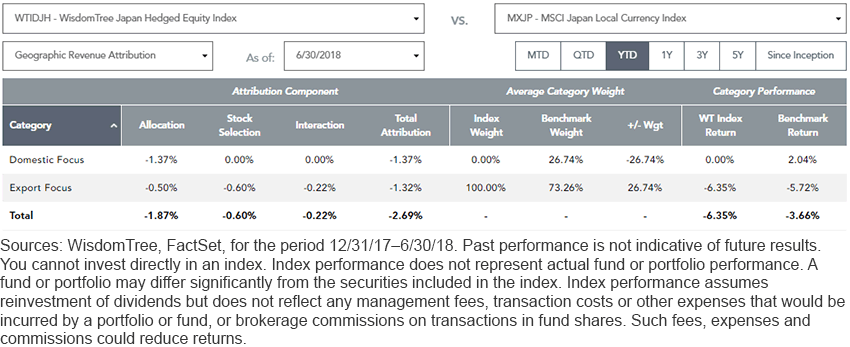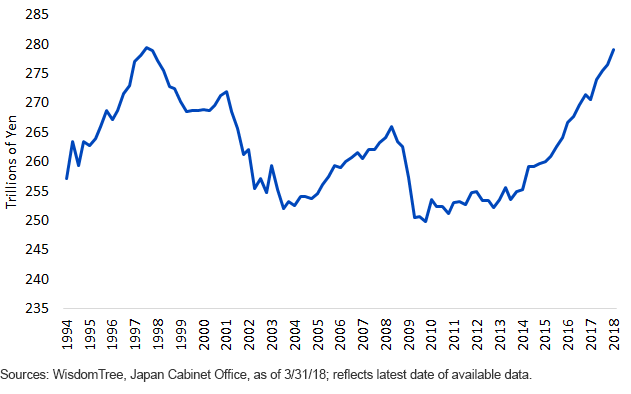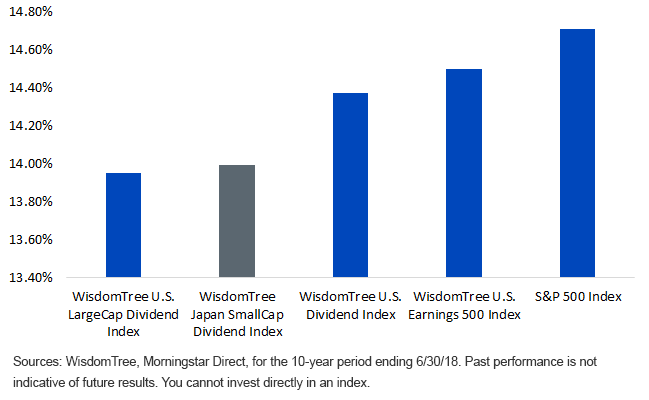How We’re Allocating To Japan Today
Since WisdomTree’s inception in 2006, Japan has been one of our areas of focus. Two of our original 20 fund launches were Japan exchange-traded funds (ETFs), and we were the first company to offer currency hedging in Japan in an ETF wrapper. Japan continues to be an area we’re passionate about—particularly as it pertains to currency hedging—and we are often asked about our thoughts on the markets there. Despite having slightly negative performance in the first half of 2018, Japan remains one of our favored regions for many reasons.
Valuations are the most attractive of any developed market, with our WisdomTree Japan Hedged Equity Index trading at just 11.4x earnings. Profitability has markedly improved in recent years, with the Tokyo Stock Price Index at an all-time high in earnings and a post-crisis high in return on equity. The Bank of Japan indicated in its July meeting that it remains committed to strong monetary stimulus through both low-interest rates and its yield curve control program. Corporate reform advancements have shown up in metrics such as record lows in cross-shareholdings1 and a fourfold increase in companies with multiple independent directors.2 This is all on top of a widening interest rate differential between the U.S. and Japan, providing investors in hedged Japanese equities a tailwind of over 2% annually (and rising).
With so many reasons to be bullish, the question almost always comes up: How should I allocate to Japan?
Digging into 2018 Performance
A recent addition to WisdomTree’s website is our Index Performance Attribution tool. While offering common attribution classifications such as basic sector and market cap breakdowns, it also analyzes different fundamental groupings, such as return on equity and volatility quintiles. In the case of our WisdomTree Japan Hedged Equity Index (which includes only export-focused companies), we also include a geographic revenue filter.
Year-to-date through June 30, the WisdomTree Index trailed the MSCI Japan Local Currency Index by 2.69%, and using the geographic revenue grouping in the attribution tool, it is clear why. Domestically focused stocks in Japan were up 2.04% through June—beating the exporters by nearly 780 basis points in just six months! Given that on a net basis the yen has roundtripped and is basically flat on the year (having started at 112, strengthening to 104 and ending June at 110), the gap in performance between those who are and are not reliant on currency fluctuations is stark.
(Click on image to enlarge)

Japan’s Domestic Market Thriving
That said, the strength of Japan’s domestic market is no surprise to us and something we have been talking about for some time. Consider the health of the U.S. labor market, with jobless claims hovering around 200,000 and unemployment down to just 3.9%. Compare that to the far stronger 2.4% unemployment rate in Japan—made even more impressive thanks to an enviable rising participation rate. There are now an astounding 1.62 open jobs for every applicant in Japan, the most since 1974.3
As a result of its demographic-aided tight labor market, Japan has broken a two-decade downward trend in wage growth, and employee cash earnings growth just reached the highest rate since 1997. The pickup in wages is trickling down to help spark domestic demand and consumption within the Japanese economy, and given this backdrop, it should come as no surprise that domestically focused stocks have outperformed in 2018.
Japan’s Nominal Wages
(Click on image to enlarge)

Biggest Beneficiaries with the Smallest Volatility
Arguably the top beneficiaries of Japan’s domestic growth revival are small caps. Japanese small caps are an underrated (and under-allocated to) asset class in our view, and they’re a longtime favorite within WisdomTree. We launched the industry’s first Japanese small-cap ETF, the WisdomTree Japan SmallCap Dividend Fund (DFJ) in 2006, beating even the market cap-weighted options to the market.
While Japan’s domestic demand story is timely, an added benefit of investing in Japan small caps is their low volatility. In fact, of every index we manage with a 10-year track record, the WisdomTree Japan SmallCap Dividend Index is the second-least volatile over that time frame—with lower volatility than indexes consisting of U.S. dividend-paying stocks, the most profitable U.S. large caps and the S&P 500. Counteracting yen exposure unquestionably helps dampen volatility, but small caps also have had less volatility than their large-cap counterparts. Counterintuitive as it may seem for small caps from a single country, Japanese small caps have effectively helped reduced risk in investor portfolios for the last decade.
(Click on image to enlarge)

How We Allocate to Japan Today
Within many of WisdomTree’s ETF model portfolios, Japan continues to be an overweight position. Outside of having broad international developed exposure, our over-weight is obtained by equally splitting a hedged Japan exporter allocation with unhedged Japan small caps.
Trade tensions aside, global growth remains strong, and given our view that U.S. interest rates will continue to tick higher over time, hedged Japan equities (which have had a high correlation to U.S. yields) could be some of the prime beneficiaries. That, coupled with the domestic momentum in Japan and the relative protection offered by the yen if global risk sentiment should turn south, suggests unhedged small caps are an unexpected safe spot.
Importantly, both the large and small caps have strong fundamentals underpinning them. Both are at all-time highs in dividends and earnings, and large and small caps alike have more than doubled their profits since the start of Abenomics.
Without a strong directional view on the yen, we think this two-pronged approach may be the best and most complete way to allocate to Japan today.
Unless otherwise indicated, all data is from Bloomberg, as of June 30th, 2018.
1Nomura Securities, for the fiscal year ending in March 2017.
2Nikko Asset Management, June 2017.
3Bloomberg, as of 6/30/18.
Disclaimer: Investors should carefully consider the investment objectives, risks, charges and expenses of the Funds before investing. U.S. investors only: To obtain a prospectus containing this ...
more


